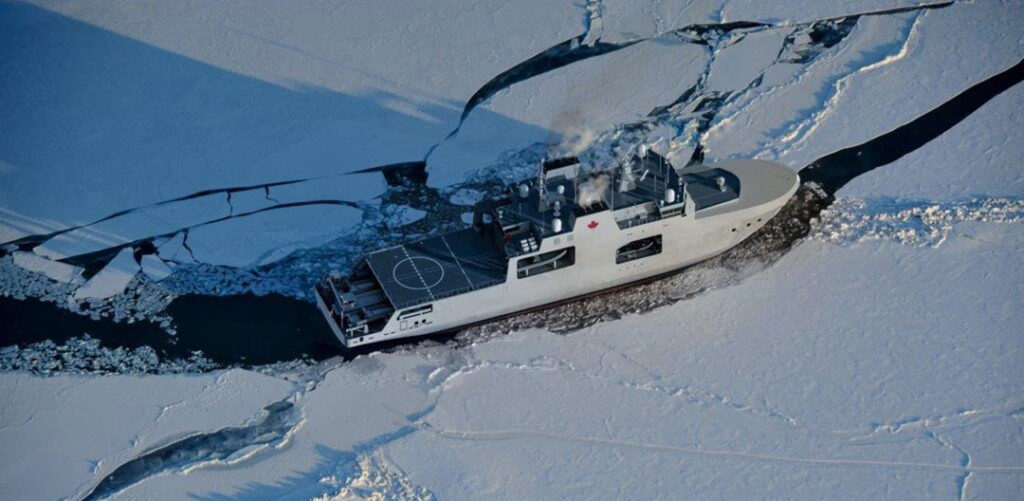A Royal Canadian Navy Arctic Offshore Patrol Vehicle patrols the icy Arctic waters. ROYAL CANADIAN NAVY
THE WATCH STAFF
Canada conducted a major exercise with its Pacific Fleet in which one of its newest vessels, HMCS Max Bernays, an Arctic Offshore Patrol Vessel (AOPV), participated. The exercise strengthens the readiness of the closest U.S. ally to protect the western approaches to the North American homelands. The task group exercise began April 22, 2024, and extended through May 3, 2024, in the Strait of Juan De Fuca, which lies near the Pacific Northwest border of the U.S, the Salish Sea and the west coast of Vancouver Island.
The Max Bernays is the third of six AOPVs scheduled to come into service as part of a major refitting of the Royal Canadian Navy (RCN). AOPVs form an important part of Canada’s defense strategy, particularly in its far northern and Arctic territories. Although lightly armed, the AOPVs can host small numbers of troops and maritime military helicopters. They can also be refitted with missiles if needed. Their strong hulls are well adapted to the icy conditions of the Arctic, especially with its rapidly melting ice sheets. The ship’s participation in the exercise marks the first time an AOPV has sailed in an exercise with Canada’s Pacific Fleet, according to the Lookout Newspaper, an RCN publication.
The Max Bernays participated in the task group exercise (TGEX 24-01) with Halifax-class frigate HMCS Vancouver, Kingston-class vessels HMCS Edmonton and Yellowknife, and Naval Replenishment Unit Asterix. Members of the Fleet Diving Unit (Pacific), Naval Tactical Operations Group and 443 Maritime Helicopter Squadron also took part, confirmed Lt. Cmdr. Ben Scott, senior staff officer, Canadian Fleet Pacific, according to the Lookout. “The goal of TGEX 24-01 is to build tactical skills among several ships simultaneously, preparing them for Rim of the Pacific (RIMPAC) and deployments to the Indo-Pacific and the Arctic later this year,” Scott said.
After training, the Max Bernays sailed to Vancouver for a May 3 ceremony during Fleet Week, the newspaper reported. Its maiden voyage to the Pacific has already seen milestones: crossing through the Panama Canal in March 2024 and refueling, crew rest and “supporting engagements” with U.S. Coast Guard officials during stops in San Diego and San Francisco. “It is a very special and proud feeling to be involved in bringing the new ship and its incredibly talented and motivated group of sailors to the Pacific Fleet,” said Lt. Cmdr. Clayton Erickson, the ship’s executive officer, the newspaper reported.
Since 2021, the AOPVs have patrolled the Arctic each summer and early fall, extending the presence of the Canadian Armed Forces (CAF) in the far north months longer than they could operate previously in the harsh environment. Capable of operating in ice that is 120 centimeters thick, ships like the Max Bernays will allow the RCN to have unescorted access to areas of the Arctic that were previously inaccessible, according to a Canadian government fact sheet. The Max Bernay is the third of six such ships to be delivered to the RCN. The final three AOPVs are in various stages of production, the government website stated, with the final ship to be delivered by 2027. Two AOPVs will also be built for the Canadian Coast Guard.

